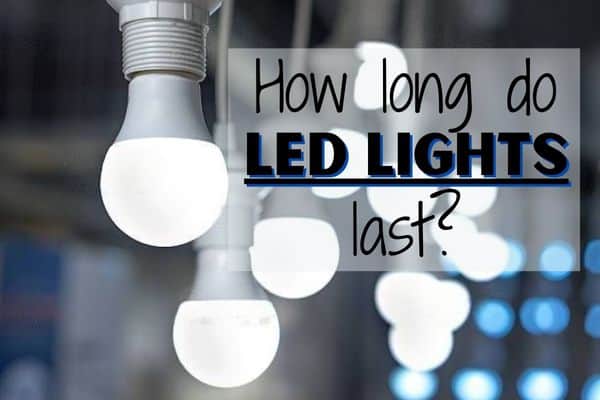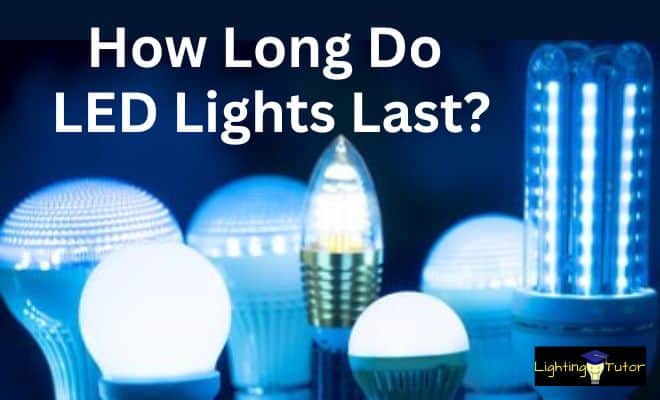Last Updated on August 6, 2023 by The Tutor

How Long Do LED Lights Last
On average, each LED bulb will last 6 or more years. Each LED light has a maximum number of hours specified by the manufacturer. To determine how long your LED light will last, simply divide the total lifetime hours indicated on the package and divide by the number of hours the light will be in use per day.
LED lights have gained popularity due to their long lifespan, energy efficiency, and cooler temperatures. In this article, we will explore the factors that influence how long LED lights last.
We will also provide tips on extending the lifespan of your LED lights and compare their longevity with other lighting technologies. Additionally, we will debunk common myths about LED light lifespan and discuss how manufacturer specifications can help you make informed decisions.
How do LED Lights Work?
With LED lights, the electrical current flows in one direction, In through the anode and out through the cathode. When electricity passes through a LED light bulb, it emits a directional light, unlike the 360-degree light that is emitted by incandescent lighting.
Exploring the Lifespan of LED Lights
LED lights have gained significant popularity in recent years due to their impressive lifespan. Understanding the factors that influence their longevity can help individuals make informed decisions when it comes to lighting choices. In this section, we will delve into the various aspects that contribute to the lifespan of LED lights.
Heat Management: Impact on LED Lifespan
One crucial factor that affects the lifespan of LED lights is proper heat management. Heat buildup can significantly reduce the longevity of LEDs, as excessive heat can damage their sensitive components. LED lights are designed with heat sinks or heat-dissipating materials to regulate temperature and extend their lifespan.
The Role of Electrical Current in LED Light Lifespan
The electrical current flowing through LED lights also plays a vital role in their lifespan. Utilizing electrical currents within the manufacturer’s recommended range ensures optimal performance and longevity. High currents can generate excess heat and strain the LED’s components, reducing their lifespan.
Significance of Proper Voltage Wiring for LED Lifespan
Proper voltage wiring is essential for maximizing the lifespan of LED lights. Incorrect wiring or fluctuating voltages can cause voltage spikes, leading to premature failure of the LEDs. It is important to ensure a stable and consistent voltage supply to prolong their lifespan.
The Effects of Environmental Conditions on LED Light Longevity
Environmental conditions can also impact the lifespan of LED lights. Exposure to extreme temperatures, excessive humidity, or corrosive elements can degrade the LED’s performance and reduce its lifespan. Therefore, it is essential to install LED lights in suitable environments to ensure their longevity.
By exploring these factors that influence the lifespan of LED lights, individuals can make informed decisions when selecting and installing LED lighting solutions. You should consider factors such as heat management, electrical current, voltage wiring, and environmental conditions to maximize the lifespan of LED lights and enjoy their long-lasting benefits.
Understanding the Factors that Influence LED Light Longevity
Many people choose LED lights because of their long lifespan. The lifespan of LED light bulbs is usually printed on the manufacturer’s packaging.
Typically, LED lights can last for five to 10 years, or even more. However, the lifespan indicated on the manufacturer’s printing is just an estimate based upon the number of hours the bulb is used
In reality, the expected lifespan of a light bulb will depend on several environmental factors and how it is used daily.
In this section, we will explore the impact of heat management, electrical current, voltage wiring, and environmental conditions will have on how long an LED lights last.
Heat Management: Impact on LED Lifespan
Effective heat management plays a vital role in determining the lifespan of LED lights. Excessive heat can accelerate the degradation of LED components and reduce their overall longevity. To ensure optimal performance, LED fixtures should be equipped with efficient heat sinks, which help dissipate heat and maintain lower operating temperatures.
The Role of Electrical Current in LED Light Lifespan
The electrical current supplied to LED lights directly affects their lifespan. LED drivers, also known as power supplies, regulate the current flowing through the LEDs. Manufacturers should use LED drivers that match the specific voltage and current requirements of the LED lights to maximize their lifespan.
Significance of Proper Voltage Wiring for LED Lifespan
Proper voltage wiring is essential for ensuring the longevity of LED lights. Using wiring that provides consistent voltage levels within the recommended range helps prevent excessive voltage drops or surges. Voltage fluctuations can impose stress on LEDs and reduce their lifespan. Therefore, you should follow manufacturer recommendations and adhere to electrical codes when installing LED lighting systems.
The Effects of Environmental Conditions on LED Light Longevity
Environmental conditions can have a significant impact on the lifespan of LED lights. Although LEDs are not susceptible to colder temperatures, extreme heat can be detrimental. Therefore, try to avoid exposing LED lights to excessive heat as it can significantly reduce their lifespan.
Other factors like humidity, dust, and exposure to corrosive substances can also contribute to premature LED failure. Proper protection and regular maintenance can help mitigate these effects and prolong LED longevity.
How to Extend the Lifespan of Your LED Lights
By following these expert tips and recommended practices referenced below, you can ensure that your LED lights shine brightly for an extended period:
Effective Tips for Reducing Heat Build-up in LED Lights
- Ensure proper ventilation and airflow around LED fixtures to dissipate heat efficiently.
- Consider using heat sinks or cooling devices to reduce the temperature around LED lights.
- Avoid overcrowding LED fixtures to prevent heat accumulation.
Read – Do LED Lights Get Hot?
Ways to Increase the Lifespan of LED Lights
- Use LED drivers or constant-current power supplies specifically designed for LED lights.
- Ensure that the electrical current supplied to the LED lights is within the recommended range.
- Avoid power surges by installing surge protectors to protect LED lights from voltage fluctuations.
- Control your usage and turn off lights when not needed.
Maximizing LED Lifespan through Optimal Fixture Design
- Choose LED fixtures with efficient heat dissipation mechanisms built-in.
- Select fixtures with high-quality components that are designed to withstand prolonged use.
- Properly position LED fixtures to prevent excessive heat transfer from adjacent heat sources.
Maintenance Strategies for Prolonging the Lifespan of LED Lights
- Regularly clean LED fixtures to remove dust and debris that can hinder heat dissipation.
- Inspect and replace any damaged or malfunctioning components promptly.
- Follow manufacturer’s guidelines for routine maintenance and cleaning procedures.
By implementing these tips and practices, you can significantly extend the lifespan of your LED lights, ensuring optimal performance and energy efficiency. Taking proactive measures to manage heat build-up, electrical current, and fixture design will ultimately lead to prolonged LED lifespan and cost savings over time.
Comparing LED Lifespan with Other Types of Lighting
When it comes to the lifespan of lighting technologies, LED bulbs outshine traditional incandescent and halogen bulbs. Let’s take a closer look at how LED lights compare:
LED vs. Incandescent and Halogen Bulbs: Lifespan Comparison
LED lights have a significantly longer lifespan compared to incandescent and halogen bulbs. While incandescent bulbs typically last around 1,000 hours and halogen bulbs around 2,000 hours, LED lights can last up to 50,000 hours or more, depending on various factors.
LEDs generate light through a process called electroluminescence, which doesn’t rely on a filament like incandescent bulbs. This lack of a filament allows LED lights to withstand shock, vibrations, and frequent on/off switching, resulting in exceptional longevity.
The Longevity Advantage of LED Bulbs over Fluorescent Lights
When compared to fluorescent lights, LED bulbs also come out on top in terms of lifespan. Fluorescent lights typically last between 7,000 and 15,000 hours. In contrast, LED lights can last more than three times longer, greatly reducing the frequency of bulb replacements and maintenance.
Additionally, LED lights start instantly without any warm-up time, unlike fluorescent lights that may take a few seconds to reach full brightness. This instant-on capability further enhances the overall lifespan of LED bulbs.
It’s important to note that the lifespan of LED lights can vary based on factors such as operating conditions, quality of components, and proper usage. However, the longevity advantage of LED bulbs over incandescent, halogen, and fluorescent lights makes them a reliable and cost-effective choice for lighting solutions in various applications.
How to Calculate a LED Light’s Lifespan?
It is possible to calculate the lifespan of a LED light bulb in years, based on your usage. For example, if your LED light is on for an average of eight hours a day for 365 days, your light bulb usage is equivalent to 2,920 hours per year.
If the LED light has an expected lifespan of 20,000 operating hours, you can expect it to last for 6.8 years.
Debunking Common Myths about LED Light Lifespan
When it comes to the lifespan of LED lights, there are several common myths that need to be addressed. Let’s debunk these misconceptions and provide accurate information.
Myth: LED Lights Last Forever
Contrary to popular belief, LED lights do not last forever. While they have a significantly longer lifespan compared to traditional lighting technologies, they will eventually wear out over time. LED lights are designed to have a long operational life, typically lasting between 50,000 to 100,000 hours, depending on various factors.
Myth: LED Light Bulbs Cannot Burn Out
LED light bulbs can indeed burn out, but their failure is different from incandescent bulbs. Instead of suddenly going dark, LED lights experience a gradual decline in brightness over time. This happens due to a failing LED driver or other components within the lighting fixture. Therefore, it’s essential to monitor the performance of LED lights and replace any dimming or faulty units accordingly.
Myth: Exposure to High Voltages Guarantees Longer LED Lifespan
Exposing LED lights to high voltages does not guarantee a longer lifespan. In fact, it can have detrimental effects on their longevity. LED lights are designed to operate within specific voltage ranges, and exposing them to higher voltages can cause overheating and premature failure. If you can provide LED lights with a stable and appropriate voltage supply it will help to ensure optimal performance and extended lifespan.
By debunking these myths and understanding the actual lifespan of LED lights, you can make informed decisions about their usage and replacement. Remember, while LEDs are highly durable and efficient, they still require proper maintenance and monitoring to ensure optimal performance over time.
Do LED Lights Ever Burn Out?
Many LEDs have a lifespan of around 50,000 hours, as compared to the 1,000 hours life expectancy of incandescent bulbs. However, the life expectancy of LED lights is not measured until it burns out. Instead, the indicated lifespan of a LED light is measured until the bulb produces approximately 30% less light.
Naturally, the light output of a LED light bulb will decrease over time. The luminous decay will happen gradually over a lighting fixture’s lifespan. When LED lights reach their nominal lifespan, the components of the bulb will age and start to function less efficiently. Fortunately, LEDs have a very high light output decay point. Thus, the light output dims slowly over time instead of failing to work abruptly.
Understanding Manufacturer Specifications: Interpreting LED Lifespan Claims
When evaluating LED lights, consider the manufacturer’s specifications regarding the lifespan of these lighting options. Being able to interpret and analyze these claims will help you make informed decisions for your lighting needs.
How Long Do LED Strip Lights Last?
Just like the regular LED light bulb, LED strip lights are also measured based on their operating hours. Typically, LED strip lights also have a lifespan of around 50,000 hours. If you choose a fixture that has high-quality components and you keep your LED strip lights on for an average of 8 hours per day for 365 days, you can expect your LED strip lights to still provide luminous lighting for 17 years with proper care and appropriate environmental temperature.
The Future of LED Lifespan: Advancements and Innovations
In the world of LED lighting, advancements and innovations continue to drive the quest for enhanced longevity. Manufacturers and researchers are constantly exploring new solutions to improve the lifespan of LED lights. This section delves into two key areas of development: heat sink solutions and emerging technologies.
Exploring Heat Sink Solutions for Enhanced LED Longevity
Heat management can impact LED lights, as excessive heat can significantly reduce their lifespan. To address this, manufacturers are focusing on improving heat sink technologies. These solutions aim to dissipate heat effectively, ensuring the LED components operate within optimal temperature ranges.
New heat sink designs incorporate advanced materials and cutting-edge thermal engineering techniques. High-conductivity materials, such as copper and aluminum alloys, are being utilized to maximize heat transfer. Additionally, innovative fin and heat pipe designs increase the surface area for better heat dissipation.
Moreover, active cooling methods like fans and liquid cooling are being employed for high-power LED applications. These cooling systems actively remove heat from the light source, ensuring stable operation and prolonged lifespan.
Emerging Technologies to Improve LED Lifespan
The future of LED lifespan also lies in the development of emerging technologies that aim to overcome current limitations. Researchers are exploring various avenues to enhance performance, efficiency, and longevity.
One such technology under investigation is using quantum dots to produce LED lights with improved color accuracy, efficiency, and longevity. Quantum dots offer greater control over color reproduction, resulting in superior lighting experiences. By harnessing the unique properties of quantum dots, researchers aim to develop LED lights that maintain their performance over extended periods.
Another area of exploration is the integration of smart lighting systems. By incorporating advanced sensors, connectivity, and controls, these systems optimize LED operation based on real-time data. Smart lighting solutions can dynamically adjust parameters such as brightness, color temperature, and energy consumption, thereby extending LED lifespan by ensuring optimal operating conditions.
- Improved heat sink technologies maximize heat dissipation for enhanced LED longevity.
- New materials and designs facilitate efficient heat transfer and cooling.
- Quantum dots hold promise for superior performance and extended lifespan in LED lighting.
- Integration of smart lighting systems offers dynamic control and optimization for prolonged LED operation.
Summary: How Long do LED Lights Last
When it comes to LED light longevity, there are important factors to consider to make informed decisions. This section highlights two key aspects: energy efficiency benefits and cost reduction, as well as factors to consider when choosing LED lights for maximum lifespan.
Energy Efficiency Benefits and Cost Reduction through Extended LED Lifespan
One of the significant advantages of LED lights is their energy efficiency, which translates into cost savings. LEDs consume less energy compared to traditional lighting technologies, resulting in lower electricity bills. Additionally, the extended lifespan of LED lights reduces the frequency of replacements, saving not only on the cost of new bulbs but also on maintenance expenses. By embracing LED technology, individuals and businesses can enjoy long-term energy efficiency benefits and significant cost reduction.
Choosing LED Lights for Maximum Lifespan: Factors to Consider
When selecting LED lights for maximum lifespan, there are several factors to take into account:
- The quality of the LED chip: Opt for reputable manufacturers known for producing high-quality LED chips, as they significantly impact the overall lifespan of the light.
- Proper heat management: Consider LED lights with efficient heat sink designs that effectively dissipate heat, as excessive heat can shorten their lifespan.
- Environmental considerations: Assess the installation environment for factors like temperature, humidity, and exposure to harsh conditions that may affect LED longevity.
- Compatibility with existing electrical systems: Ensure LED lights are compatible with existing wiring, fixtures, and control systems to avoid any compatibility issues that may impact their lifespan.
- Manufacturer warranties: Look for LED lights that come with reliable warranties, indicating the manufacturer’s confidence in their product’s longevity.
By considering these factors and making the right choices, individuals and businesses can maximize the lifespan of their LED lights, enjoying the benefits of energy efficiency and cost reduction in the long run.

